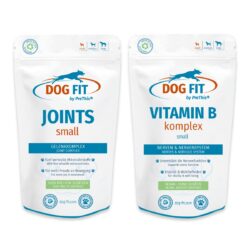Herniated disc in dogs
Intervertebral Disc Herniation – Causes and Symptoms
A herniated disc in dogs is usually caused by age-related wear and tear or excessive strain on the spine. Over time, the intervertebral discs lose their elasticity, dry out, and can shift or protrude. Dog breeds with long backs, such as dachshunds, Pekingese, or cocker spaniels, are particularly at risk. Obesity, lack of exercise, and a consistently unbalanced or predominantly dry diet also contribute to the wear and tear of the intervertebral discs.
Symptoms of a Herniated Disc
The symptoms of a herniated disc range from back pain and restricted mobility to visible changes in gait. In more severe cases, neurological abnormalities such as tremors, paralysis, incontinence, dragging paws, or balance problems can occur. Many dogs avoid stairs, no longer jump into the car, or exhibit a hunched posture. Depending on the severity, veterinary evaluation is urgently recommended. Modern imaging techniques such as MRI or CT scans help to reliably diagnose a herniated disc and rule out other causes such as spondylosis or hip dysplasia.
Therapeutic approaches: Conservative and surgical options
The primary goal is to relieve pain, contain inflammatory processes, and relieve pressure on weakened structures. In addition to administering painkillers, physiotherapy measures such as massages, underwater treadmills, or targeted exercise therapy can be helpful. Sufficient rest periods, a back-friendly environment, and a soft, well-padded bed are also important.
In severe cases—especially if permanent paralysis or severe neurological deficits occur—surgery may be necessary. The goal of surgery is to reduce pressure on the affected nerve structures and thus increase the chances of improved function. The decision to undergo surgery is always made on an individual basis and should be made in close consultation with the treating veterinarian.
Role of Micronutrients
As part of a balanced diet, micronutrients can contribute to supporting the normal function of intervertebral discs, nerve pathways, and the surrounding connective tissue. The nervous system, in particular, benefits from an adequate supply of B vitamins. Selected nutrients such as glucosamine, MSM, devil’s claw, and collagen can also be beneficial for the supply of intervertebral discs, vertebral bodies, tendons, and fascia. However, targeted supplementation of the diet should always be tailored to the individual and in consultation with the veterinarian.
Potential contributions of targeted micronutrient supply
- Supporting the normal function of intervertebral discs and vertebrae
- Contribution to physiological impulse transmission in nerve structures
- Nutritional support for special challenges to coordination or bladder function
- Supplementary supply of surrounding tissue such as tendons and ligaments
Aftercare, Exercise, and Prevention
After diagnosis, individually tailored aftercare is particularly important. Gentle exercise, physiotherapy, and regular veterinary check-ups can support the recovery process. An appropriate diet, maintaining a healthy body weight, and avoiding sudden movements help prevent relapses.
Important note for dog owners:
The care of dogs with back problems should always be individualized and under veterinary supervision. Careful observation and a balanced diet are important building blocks for the dog’s well-being.
Pay attention to your dog’s needs in everyday life and provide him with as much comfort as possible, as well as a safe and quiet place to retreat to. This will best support him on his path to greater joy of movement.

